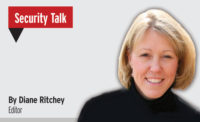More than a quarter of U.S. households have ditched their landline phones and gone 100-percent mobile, a trend driven by younger Americans relying on their cellphones, according to Census Bureau data. Just 71 percent of households had landlines in 2011, down from a little more than 96 percent 15 years ago. Cellphone ownership reached 89 percent, up from about 36 percent in 1998, the first year the survey asked about the devices. The youngest households are abandoning landlines in droves. About two-thirds of households led by people ages 15 to 29 relied only on cellphones in 2011, compared with 28 percent for the broader population.
Kristi Jennings, Vice President of ESC Central in Birmingham, Alabama, first looked into BoldSOS from Bold Technologies because of that trend. ESC Central provides two-way Voice monitoring and had encountered an increasing number of dealers asking if ESC Central could support users without landlines that only have a cell phone. Jennings implemented BoldSOS as a solution to the challenge of providing Personal Emergency Response Systems (PERS) services and more to users with only a mobile device.
“PERS systems are specific to someone’s house. BoldSOS opens up new possibilities for PERS on a mobile basis. The first question I am always asked is if the PERS device will work if someone is at their mailbox, or out in their backyard. With this app, [users] get PERS with a touch of a button no matter where they are,” says Jennings.
Jennings noted that the notification feature has also been a popular function, one which ESC Central has been successful in marketing. “Consider a scenario where you have a child who is supposed to notify you when they reach a certain place,” says Jennings, “With this application, the child can simply hit the notification button to send the message that they have arrived, and the notification comes through with location information so you know the child is where they are supposed to be.”
Jennings also shared an interesting story about a customer selling the app services in a unique way. The ESC Central customer is an avid cyclist who will often go for several-hour bike rides, which used to cause concern because the cyclist’s family would not know where he was. The cyclist now uses BoldSOS and will stop periodically and send a notification through the app; with one quick push of a button he can send a notification to his wife to check-in and provide his location information. The cyclist can also use the app if in a situation where he needs assistance; for example, if he has a flat tire. The app enables him to quickly send the “needs assistance” notification along with his location information. This customer identified a potential market for other cyclists and decided to offer a solution called CyclingSOS, providing Emergency Services, Impact Monitoring, Notifications and Location Tracking.
Privacy Concerns and Misconceptions with People Tracking and RFID
In Minnesota, Sen. Al Franken (D-Minn.) is reintroducing a new piece of privacy legislation that prevents companies and government organizations from tracking a person’s location data.
The Location Privacy Protection Act of 2014 (LPPA), seeks to stop “loop holes and technicalities” that allow some organizations to gain access to the data while also giving consumers control over all location-based data that many Web services use, especially services that take place over smartphones and other Internet-connected mobile devices.
According to a report by ABC News, the bill will force Web services to gain permission from consumers before collecting and sharing location data collected on smartphones, tablets, or in-car navigation devices. It also requires any company tracking more than 1,000 people to publicly disclose location data tracking activity as well as why it’s collecting that data. The bill also would ban all “GPS stalking” applications and calls for law enforcement to seize any profits made from them to help fund further education about stopping location data-privacy violations.
“Most Americans have smartphones now. And the companies that make the software on your phone, including apps, can access extremely sensitive location data that reveals where you live, where you work, where you drop your kids off at school, the church you attend, and the doctors you visit,” Franken said in a statement. “I believe that Americans have the right to control who can collect that information, and whether or not it can be given to third parties. But right now, companies — some legitimate, some not — are collecting your location and giving it to whomever they want,” he said. “My commonsense bill helps a whole range of people, and would finally put an end to GPS stalking apps that allow abusers to secretly track their victims.”
Most people think that biometrics and RFID are the same as tracking, which tends to lump privacy concerns with people tracking with the latter, but according to Kathleen Carroll, Director of Government Relations at HID Global, that’s the wrong way of thinking. “These technologies are authentication technologies, not tracking technologies, such as a GPS in a mobile phone are tracking. RFID and biometrics will authenticate an individual, so for example, a school district in Florida using palm prints to authenticate students in the lunch line. That is not tracking. It’s not the same as RFID or biometrics,” she says.
“From a privacy perspective, tracking is one of the top issues when you talk about biometrics and RFID,” Carroll says. “Both of these technologies are used mainly for authentication, and when it comes to people, but there is perception that you can be tracked.”
Recently, some K-12 schools across the country have banned biometrics, such as in Florida, with Bill 188, which bans the collection of biometric information from students.
“In the Florida schools there was a real concern about the capture of the biometrics and the ability for hackers and law enforcement to access that biometric data,” Carroll explains. “But it’s not a legitimate concern in terms of that in most instances, when a biometric is captured it is not the actual biometric, it becomes a template, so for example, a child gives their palm print, and it is turned into a series of ones and zeroes. A hacker doesn't see the actual palm print. All they see is ones and zeroes because the data is encrypted. What is more critical is biographic data, such as sex, age, name, birth date and Social Security number: that is what hackers go for.”
“Second, from a law enforcement perspective, if law enforcement wanted to access a biometric there are laws on the books that require them to get a court order. Biometrics are protected from law enforcement that way.”
Carroll notes that biometrics can assist a K-12 school with funding, and cites preschools in California that are using RFID to automatically take attendance so that they can get head start funding. “The more accurate their attendance numbers are, the more funding they can get,” she says.
The Federal government is exploring the use of biometrics for exit out of the U.S., Carroll adds. “The U.S. government already requires biometrics from foreign citizens to get into this country, and this bill would introduce a program so that we know when foreign nationals leave. From a privacy perspective, any implementation should take a privacy by design approach, so that even before you implement a system, you conduct a privacy impact assessment and you look all areas where personally identifiable information might be vulnerable and address it before you put the system in. At HID, we also recommend that users of biometrics and RFID apply the Fair Information Practice principals, which, when followed correctly, will go a long way to ensure that solutions, whether it’s RFID or biometrics are privacy protective,” Carroll says.









